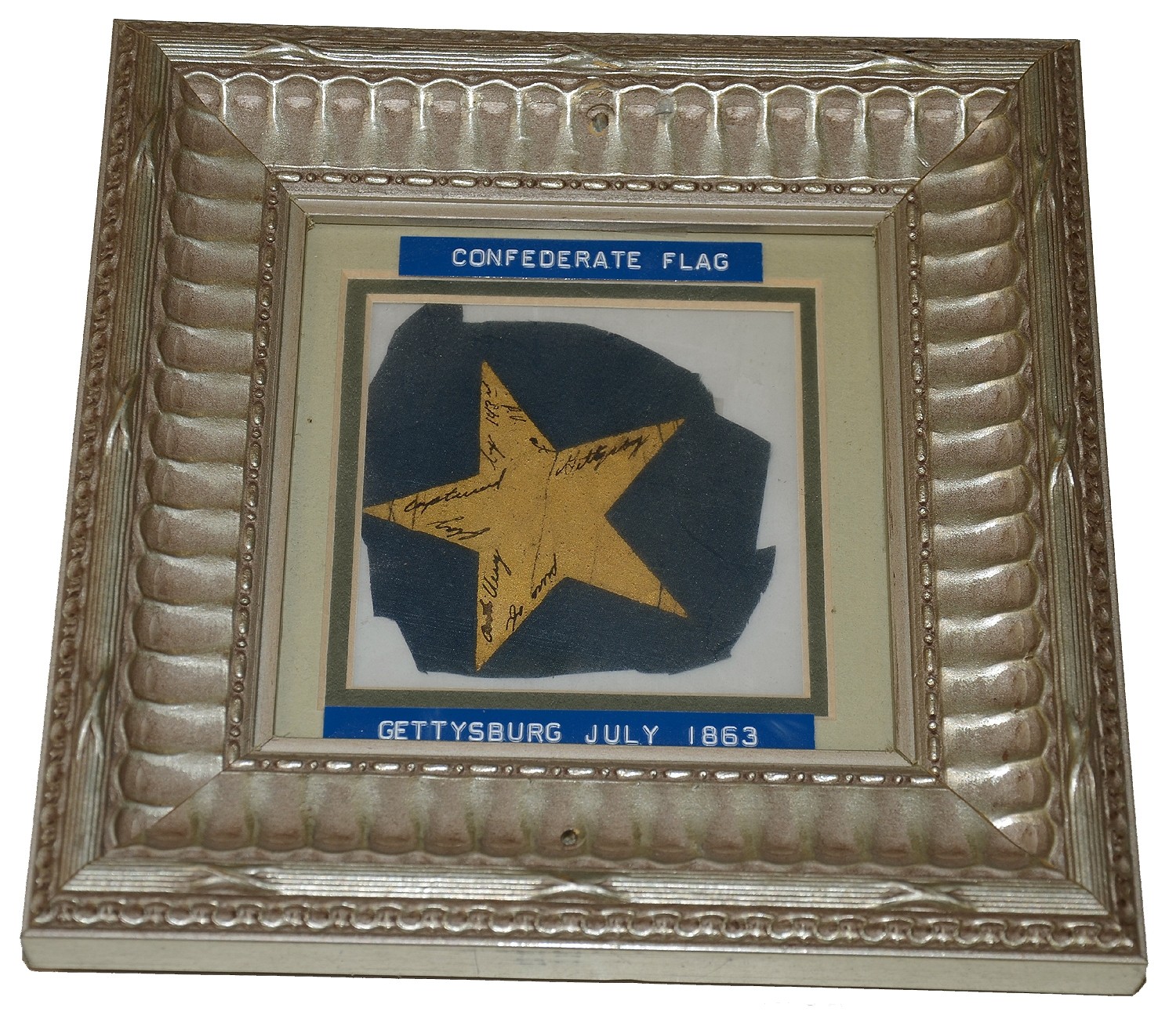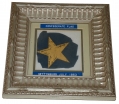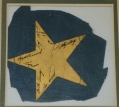site search
online catalog
FLAG FRAGMENT: 143rd PENNSYLVANIA VOLS. AT GETTYSBURG

$2,250.00 SOLD
Quantity Available: None
Item Code: 1054-1019
This flag fragment recently came out of a collection we purchased. It measures about 3 ¼ by 3 ¼ inches overall, and is blue silk with a gold painted five-pointed star measuring about 2 ¾ inches point to point. A dead-real, old ink inscription around the inner edges of the star reads, “Piece of / Conf. Army / flag / Captured by 143rd/ P.V. at / Gettysburg.” The iron of the ink has burned “Conf” slightly, but that is the only thing it can say in the context. The only problem, of course, is that the regiment did not capture a Confederate flag at Gettysburg. We think the error arose when piece entered a veteran’s family scrap book and was incorrectly labeled as coming from a flag captured by the 143rd at Gettysburg, when it was in fact from a flag carried by the regiment at Gettysburg, something no less interesting and even more historically important.
Those familiar with Gettysburg regiments and their monuments will immediately recall the 143rd Pennsylvania’s main monument on the field of the first day’s fighting, which features a bas-relief of Color Sergeant Ben Crippen turning to shake his fist at advancing Confederates as the regiment, outflanked by elements of A.P. Hill’s corps, staged a grudging withdrawal. This was all the more remarkable as it was the unit’s first real engagement. Recruited in the summer of 1862, organized at Wilkes Barre and mustered in from August 26 to September 10 for three years service, they were assigned to Roy Stone’s bucktail brigade (the 149th and 150th) in the First Army Corps and suffered no casualties at Chancellorsville. At Gettysburg on July 1, however, with the brigade’s other regiments, they were heavily engaged near the Chambersburg Pike, facing first north and then west before being forced to pull back.
The regiment carried two flags in the battle: a blue regimental color and a state color, carried by Crippen, that was purchased by the state from Horstmann, and followed the pattern specified by the state: a U.S. flag with the state seal of Pennsylvania surrounded by 34 stars painted in the canton. Arthur Fremantle, a British observer with Lee’s forces, talked with A.P. Hill on the field, who pointed out, “a field in the center of which he had seen a man plant the regimental color, round which the regiment had fought for some time with much obstinacy, and when at last it was obliged to retreat, the color-bearer retired last of all, turning round every now and then to shake his fist at the advancing Rebels. General Hill said he felt quite sorry when he saw the gallant Yankee meet his doom.”
The flag was retrieved by the sole unwounded member of the color-guard and carried through the rest of the war. It exists today in shreds only, with none of the state seal or stars, whereas the regimental color, retired in 1864, is largely intact and preserves all of its 34 stars in an arc over the eagle. Photos of both flags may be seen in Sauers, Advance the Colors, and in great detail on-line under Pennsylvania Civil War Battle Flags as part of the PA Capitol Preservation Committee site. A wartime, or immediately postwar, CDV of the flag illustrated in Sauers, shows that it largely intact and looking no worse than the regimental flag.
There were many opportunities to “souvenir” pieces of the state colors during the war and after the war during public celebrations and even private viewings. When the regiment mustered out in June 1865 the state flag was left in Harrisburg, but was then borrowed by the Colonel for July 4 celebrations in Wilkes Barre and not returned until August. In 1866 it was taken to the Independence Day parade and celebrations in Philadelphia and then back to Harrisburg. And, in 1914 the flags of the 143rd were part of the grand procession on Flag Day, when they were installed in the PA Capitol rotunda, carried by four veterans of the regiment. Between those times, all the flags were also moved in 1893 and 1895. But there many opportunities from 1866 to 1893. The flags had been placed in glass cases in 1866, but the state Adjutant General reported that a flag might be taken out, “to gratify a soldier or the heirs or representatives of a solider desirous of seeing the flag under which he fought or fell. To such they are always cheerfully exhibited.” (Sauers, 1.30.)
The 143rd has two monuments at Gettysburg. One, erected in 1895, marks its position on July 1 and 2, where it lost 16 men. The main monument, erected on the first day’s field in 1889, shows Crippen holding the flag and shaking his fist. The incident was obviously very much on the mind of the regiment’s veterans even if a relative may have misunderstood the significance of a treasured memento. [sr]
[SR]
~~~~~~~~~~~~~~~~~~~~~~~~~~~~~~~~~~~
THIS ITEM, AS WITH ALL OTHER ITEMS AVAILABLE ON OUR WEB SITE,
MAY BE PURCHASED THROUGH OUR LAYAWAY PROGRAM.
FOR OUR POLICIES AND TERMS,
CLICK ON ‘CONTACT US’ AT THE TOP OF ANY PAGE ON THE SITE,
THEN ON ‘LAYAWAY POLICY’.
THANK YOU!
Inquire About FLAG FRAGMENT: 143rd PENNSYLVANIA VOLS. AT GETTYSBURG
For inquiries, please email us at [email protected]
Most Popular
Historical Firearms Stolen From The National Civil War Museum In Harrisburg, Pa »
Theft From Gravesite Of Gen. John Reynolds »
Cavalry Carbine Sling Swivel »
Fine Condition Brass Infantry Bugle Insignia »
featured item
RARE CONFEDERATE “THREE SQUARE” SOCKET BAYONET
This is an excavated example of a Confederate-made musket socket bayonet. Measuring 21” overall with a 2.75” socket. This was made for an early .69 caliber musket with a bayonet lug mounted on the bottom of the barrel; as the bridge is on the… (2022-459). Learn More »




